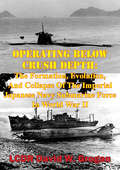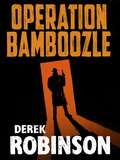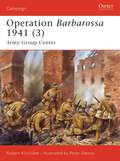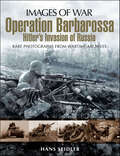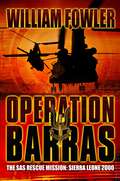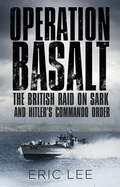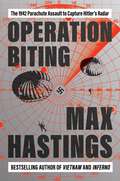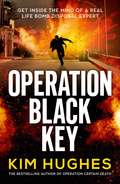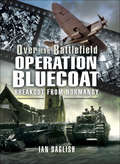- Table View
- List View
Operación Nimrod: el asedio a la embajada iraní
by Russell Phillips Catherine Vidal GonzálezAl efectuar una extensa investigación, la Operación Nimrod nos (alejará de los mitos y revelerá la verdad) sobre aquellos seis largos días, junto al dramático rescate que desplegó el SAS bajo la mirada pública. El 29 de abril de 1980, la policía británica le aseguró a Irán que su embajada era segura. Sin embargo, al día siguiente, los terroristas asediaron la embajada y tomaron veinte y seis rehenes. El gobierno iraní estaba dispuesto a que los rehenes se convirtieran en mártires, mientras que el gobierno británico solo estaba dispuesto a conversar si los terroristas se rendían. A toda esta tensión se añadían los veinte y seis rehenes que pendían de un hilo. A esto le siguieron seis días de terror y tensión. No obstante, todo finalizó cuando el SAS comenzó la operación de rescate televisada en vivo, mientras millones de personas contenían su respiración, a la espera de poder ver el resultado de la Operación Nimrod. Compra este libro para saber la verdad acerca de la misión de rescate más dramática que asumió el SAS.
Operación Overlord
by Hannah HoweFuera había oscuridad total. Dentro, Guy parecía calmado, sus rasgos no dejaban ver emoción alguna. Mimi estaba inquieta, sus pequeños píes entraban en constante contacto con la tarima. Henri y Paul bromeaban por medio de lenguaje de signos. Hélène y Kadia se miraban nerviosas. Aymer masticaba una caña de maíz mientras se apoyaba contra la pared. Jean-Claude afilaba su cuchillo con una piedra de afilar. Bernard intentaba sintonizar la radio, para encontrar señal. Yo acariciaba mi vientre, intentando distinguir mis nervios de las patadas del bebé. Se escuchó el fuerte sonido de un reloj de pie en el pasillo. Les sanglots longs des violons de l’automne. Todas nuestras miradas se dirigieron a la radio. Nos quedamos en silencio cuando escuchamos las palabras del locutor. Era la primera estrofa del poema de Paul Verlaine; «Chanson d’automne», los largos sollozos de los violines de otoño. El locutor acababa de dar la señal que anunciaba el comienzo de la invasión.
Operación Rose: La guerra de Eve: Heroínas de la DOE (Serie Heroínas de la DOE #7)
by Hannah HoweOperación Rose es el séptimo libro de la serie La Guerra de Eve: Heroínas de la DOE
Operación Valkiria (Historia Incógnita)
by Jesús Hernández Martínez20 de julio de 1944. Von Stauffenberg se reúne en el cuartel general de Hitler. Porta un maletín con un explosivo inglés de 1 kg que se activa mediante un detonador químico absolutamente silencioso. Todo es perfecto, cree, y se sienta junto al líder nazi, Sólo queda esperar el momento...
Operación Zigzag: La Guerra de Eva; Las heroínas de la SOE
by Hannah HoweLa Guerra de Eva es una serie de doce novelas. Cada libro contiene alrededor de 20,000 palabras y una historia completa. Por favor, note que el precio de toda la serie se establece al nivel mínimo y que el arco histórico de la serie concluye hasta el último libro. Marsella, Diciembre de 1942 “Estamos en un aprieto” Dijo Vincent. “La Gestapo acaba de capturar a un agente británico con el nombre clave de Zigzag. Lo capturaron al descubrir que sus documentos de identidad eran falsos, y aunque aún no han descubierto quién es él realmente, estoy seguro que lo descubrirán y lo harán hablar. Al final de cuentas, todos lo terminan haciendo, y cuando lo haga, terminará revelando secretos que destruirán la red de resistencia local, incluyendo la nuestra. Pero hay una forma de salir de esto; a través de un guardia que esté dispuesto a sobornos. Queremos que lo encuentres y lo sobornes para que libere a Zigzag de la prisión de la Gestapo y después lo escoltes a través de las montañas, hasta llegar a España”. “¿Por qué yo?” Pregunté. “Porque tu ayudaste a establecer la red de escape y porque conoces los senderos de las montañas como si fueran la palma de tu mano. Además, al ser la esposa del respetado industrialista Michel Beringar no levantaras ninguna sospecha”. Miré a Michel. La mirada seria en su rostro me decía que no estaba contento. ¿Estaba arriesgando demasiado? ¿Y si levantaba sospechas y la Gestapo me seguía al espiar mi teléfono? Desde chica me escapé de casa. Cuando fui una adolescente viajé por el mundo viviendo de mi ingenio. Al ser periodista, presencié atrocidades hechas en nombre del fascismo. Siendo un miembro de la resistencia supe lo que era afrontar el miedo y vencerlo. He vivido lo suficiente estos últimos treinta años. Sé que puedo lograrlo. Sin embargo, incluso cuando expresé mi acuerdo, sabía que mi vida en Marsella y mi vida con Michel nunca vo
Operating Below Crush Depth: The Formation, Evolution, And Collapse Of The Imperial Japanese Navy Submarine Force In World War II
by LCDR David W. Grogan USNPrior to entering World War II, the Japanese Navy did a considerable planning and force development in preparation for a single "decisive battle" with the American fleet. The Japanese submarine force entered the war with highly trained crews operating some of the most capable submarines in the world. Even so, they accomplished little. This study will analyze the genesis and evolution of the technological basis of the Japanese submarine fleet before and during the war. Along with the technological evolution, it will also review the strategic and tactical evolution of the force. It will further analyze the employment of submarines as they apply to two major forms of naval warfare: guerre de course and guerre de main. While the entire study will use comparison with the American and German, the majority of the focus will be on the unique aspects of the Japanese employment of their submarines. These analyses will answer whether the Japanese submarine force would have been capable of influencing the results of major battles and the overall campaign in the Pacific Ocean. Could the Japanese submarine force have influenced the result of the war allowing it to end with a more favorable outcome for the Japanese?
Operation Alacrity
by Norman HerzTo win the war against German U-boats, the Allies had to protect their convoys in the vast black hole of the mid-Atlantic known as the Azores Gap. In 1943 they devised a plan to set up air bases on the Azores Islands, owned by neutral Portugal. It was essential for the operation to remain secret because the Allies had to get there before the Germans, who had their own plan to build bases. Author Norman Herz took part in the Allied operation as a corporal with the U.S. Army Corps of Engineers' 928th Engineer Aviation Regiment. At the time he was given little information about the operation and told never to talk about what he did. After the war, Operation Alacrity remained mostly unknown, kept secret, Herz suggests, so the U.S. government would not be embarrassed--they had claimed they would not invade the Portuguese territory. In researching the book, Herz found not a word of the operation mentioned in any official U.S. history of World War II but a treasure trove of declassified memos and others documents from the files of the U.S. Joint Chiefs of Staff and the Combined U.S. U.K. Chiefs of Staff and in state department files. The story is filled with diplomatic intrigue and double-dealing, including secret meetings between Franklin Roosevelt and Winston Churchill and Churchill's use of a 1373 treaty with Portugal to justly landing in the Azores. The story also involves all of the Allied engineering branches, from U.S. Navy Seabees to RAF Sappers. The success of their operation is undeniable. U-boats stopped patrolling the Azores Gap and not a single Allied troopship was lost again in the area. Today the base is an important link to American and NATO defense worldwide.
Operation Bamboozle
by Derek RobinsonFrom 1941 to 1943 it was the Germans. Then it was the turn of the British. Come the Cold War, he's conning McCarthy. Now he's going head to head with the L.A. mob.For high stakes con artist Luis Cabrillo, once known as Eldorado, the million-dollar spy, trouble is never far away. And when he and his corker-of-a-New-Yorker squeeze, Julie Conroy, run into the cream of Los Angele's shady side, the result is a heady brew of disorganized crime, hot dollars, triple virgins and dead bodies in the begonias. The fourth and final Luis Cabrillo novel is yet another fiendishly plotted rollercoaster ride of wit and wisecracking, as the Second World War's most daring and audacious spy finds that old habits die hard, even in peacetime.
Operation Bamboozle
by Derek RobinsonFrom 1941 to 1943 it was the Germans. Then it was the turn of the British. Come the Cold War, he's conning McCarthy. Now he's going head to head with the L.A. mob. For high-stakes con artist Luis Cabrillo, once known as Eldorado, the million-dollar spy, trouble is never far away. And when he and his corker-of-a-New-Yorker squeeze, Julie Conroy, run into the cream of Los Angeles' shady side, the result is a heady brew of disorganised crime, hot dollars, triple virgins and dead bodies in the begonias. The fourth and final Luis Cabrillo novel is yet another fiendishly plotted rollercoaster ride of wit and wisecracking, as the Second World War's most daring and audacious spy finds that old habits die hard, even in peacetime.
Operation Bamboozle
by Derek RobinsonFrom 1941 to 1943 it was the Germans. Then it was the turn of the British. Come the Cold War, he's conning McCarthy. Now he's going head to head with the L.A. mob. For high-stakes con artist Luis Cabrillo, once known as Eldorado, the million-dollar spy, trouble is never far away. And when he and his corker-of-a-New-Yorker squeeze, Julie Conroy, run into the cream of Los Angeles' shady side, the result is a heady brew of disorganised crime, hot dollars, triple virgins and dead bodies in the begonias. The fourth and final Luis Cabrillo novel is yet another fiendishly plotted rollercoaster ride of wit and wisecracking, as the Second World War's most daring and audacious spy finds that old habits die hard, even in peacetime.
Operation Barbarossa
by Robert KirchubelIn the first 6 months of Hitler's World War II Nazi invasion, over 5 million of Stalin's Russian troops were killed, wounded, or captured defending their Motherland. Germany's surprise assault on the Soviet Union in June 1941, Operation Barbarossa, aimed at nothing less than the destruction of the Soviet Union. Adolf Hitler saw this as the last vital step in the establishing of 'Lebensraum' for the German people in the East.Three German Army Groups, supported by numerous European allies, poured across the Soviet border crushing all before them in a lightning campaign that threatened to eliminate all Soviet resistance and secure an easy victory. However, the vast resources and size of Soviet Russia caused the German armoured spearheads to slow and the advance finally ground to a halt within sight of Moscow itself, and with it Hitler's dreams of a quick victory.This book combines Osprey's three Campaign titles on the Barbarossa campaign, along with new material specifically created, in order to tell the story of one of definitive campaigns of World War II.
Operation Barbarossa 1941
by Howard Gerrard Robert KirchubelOsprey's second title examining the events of Operation Barbarossa. Of the German Army Groups that attacked Soviet Russia, Von Leeb's Army Group North, tasked with seizing the Baltic States and Leningrad, was the smallest and weakest. General Kuznetzov's Northwestern Front, however, was in an even weaker state. Despite brave counterattacks and defense by the Soviet forces, the Germans smashed through the Dvina Line, then the Stalin Line, flooded into Latvia and pressed on to encircle Leningrad. This book examines the German offensive and also the courageous Soviet attempts to halt the German spearhead, defending every possible line against overwhelming odds.
Operation Barbarossa 1941
by Peter Dennis Robert KirchubelOsprey's third and final volume in the Barbarossa trilogy, this title completes the account of the strategic intricacies of the German campaign against Russia. Detailing the final Nazi push for Moscow, Robert Kirchubel examines the causes behind the German failure, including the inability to re-supply troops or provide reserves, and the lack of decent German winter uniforms and transport.Full-color artwork, maps and bird's-eye views illustrate the campaign in detail, revealing how the Red Army capitalized on every German weakness in spite of its own flaws.
Operation Barbarossa 1941 (Stackpole Military Photo Series)
by Michael Olive Robert J. EdwardsPhoto chronicle of the German invasion of the Soviet Union in 1941.
Operation Barbarossa and Germany's Defeat in the East
by David StahelOperation Barbarossa, the German invasion of the Soviet Union, began the largest and most costly campaign in military history. Its failure was a key turning point of the Second World War. The operation was planned as a Blitzkrieg to win Germany its Lebensraum in the east, and the summer of 1941 is well-known for the German army's unprecedented victories and advances. Yet the German Blitzkrieg depended almost entirely upon the motorised Panzer groups, particularly those of Army Group Centre. Using archival records, in this 2009 book David Stahel presents a history of Germany's summer campaign from the perspective of the two largest and most powerful Panzer groups on the Eastern front. Stahel's research provides a fundamental reassessment of Germany's war against the Soviet Union, highlighting the prodigious internal problems of the vital Panzer forces and revealing that their demise in the earliest phase of the war undermined the whole German invasion.
Operation Barbarossa: Hitler's Invasion of Russia (Images of War)
by Ian BaxterHitler's decision to renege on his alliance with Stalin and invade Russia in June 1941 was to have the most far reaching consequences for the world. Indeed, if there was one critical turning point in the Second World War, it would have to be this. The latest book in the Images of War series uses over 300 rare contemporary photographs to capture the scale, intensity and brutality of the fighting that was unleashed on 22 June 1941. No less than 4.5 million men of the Axis Power advanced on a 2,900 kilometer front. We see how the apparently unstoppable German led assaults crushed the Soviet resistance. But not for the first time Russian determination aided by the terrible winter conditions and over extended lines of communication checked the Nazi onslaught. In the annals of warfare there has never arguably been such a bitter and costly campaign.
Operation Barbarossa: Hitler's Invasion of Russia 1941
by David M GlantzOn 22 June 1941 Hilter unleashed his forces on the Soviet Union. Spearheaded by four powerful Panzer groups and protected by an impenetrable curtain of air support, the seemingly invincible Wehrmacht advanced from the Soviet Union's western borders to the immediate outskirts of Leningrad, Moscow and Rostov in the shockingly brief period of less than six months. The sudden, deep, relentless German advance virtually destroyed the entire peacetime Red Army and captured almost 40 percent of European Russia before expiring inexplicably at the gates of Moscow and Leningrad. An invasion designed to achieve victory in three to six weeks failed and, four years later, resulted in unprecendented and total German defeat. David Glantz challenges the time-honoured explanation that poor weather, bad terrain and Hitler's faulty strategic judgement produced German defeat, and reveals how the Red Army thwarted the German Army's dramatic and apparently inexorable invasion before it achieved its ambitious goals.
Operation Barras
by William FowlerThe inside story of the most daring SAS rescue mission everIn September 2000 eleven British soldiers were captured by a notorious militia gang in Sierra Leone. The so-called 'West Side Boys' had subjected their part of the country to a long reign of terror, murdering, kidnapping and mutilating anyone who stood in their way.Now British soldiers were at their mercy. Surrounded and hopelessly outnumbered, any resistance would have seen them all killed; yet their hopes of a quick exchange soon faded. They were assaulted and subjected to mock executions. Negotiations with the 'Revolutionary United Front' leaders and the 'West Side Boys' proved futile. Prime Minister Tony Blair ordered the armed forces to get the men back. The SAS and elements of the Parachute Regiment were rushed to West Africa and a naval squadron assembled offshore. The stage was set for the biggest British military operation on the continent for a generation - and their most daring rescue mission ever.
Operation Barras: The Sas Rescue Mission Sierra Leone 2000 (Sven Hassel War Classics)
by William FowlerThe inside story of the most daring SAS rescue mission everIn September 2000 eleven British soldiers were captured by a notorious militia gang in Sierra Leone. The so-called 'West Side Boys' had subjected their part of the country to a long reign of terror, murdering, kidnapping and mutilating anyone who stood in their way.Now British soldiers were at their mercy. Surrounded and hopelessly outnumbered, any resistance would have seen them all killed; yet their hopes of a quick exchange soon faded. They were assaulted and subjected to mock executions. Negotiations with the 'Revolutionary United Front' leaders and the 'West Side Boys' proved futile. Prime Minister Tony Blair ordered the armed forces to get the men back. The SAS and elements of the Parachute Regiment were rushed to West Africa and a naval squadron assembled offshore. The stage was set for the biggest British military operation on the continent for a generation - and their most daring rescue mission ever.
Operation Basalt: The British Raid on Sark and Hitler's Commando Order
by Eric LeeGerman soldiers assigned to guard the tiny Channel Island of Sark described it as a ‘little Paradise’ and, because it was never bombed by the RAF, the best air-raid shelter in all of Europe. But paradise for them came to a bloody end in October 1942 when a small group of British Commandos raided the island, capturing one German soldier and killing several others. Operation Basalt would have been a footnote in history but for the reaction of Hitler, who believed that British soldiers executed several Germans who had already surrendered and whose hands were bound. Days after the raid, he issued the infamous ‘Commando Order’, a death sentence for those Allied commandos who fell into German hands. Drawing on extensive archival research and interviews with survivors of the period, Eric Lee has written the definitive account of the raid, putting it into the context of the German occupation of British lands during the war.
Operation Biting: The 1942 Parachute Assault to Capture Hitler's Radar
by Max HastingsIn this enthralling history, internationally bestselling author Max Hastings recounts the odds-defying Operation Biting, a 1942 parachute commando raid on Northern France to steal vital components of German intelligence—one of the most thrilling British commando raids of World War II, and one of the most successful. In February 1942, RAF intelligence was baffled by a newly identified radar network on the coast of Nazi-occupied Europe, codenamed Würzburg. British intelligence proposed an assault to capture key components. Incredibly brave agents of the French Resistance risked their lives to probe the German defenses on the Normandy coast. Then a company of Airborne forces were dropped into France in the dead of night amid heavy snow. Launching their attack, the allied soldiers dismantled the German’s radar, and after three nail-biting hours and a fierce battle with Wehrmacht defenders, escaped in the nick of time using landing-craft that carried them back across the stormy seas to Portsmouth.Operation Biting retells this dramatic operation through a gallery of amazing characters from Winston Churchill, who promoted the raid, to Lord Mountbatten, who commanded Combined Operations, to the brave unsung commandos who fought their way through enemy territory.A cliffhanger of a story that ratchets the suspense to the last page, Operation Biting sheds new light on an exciting and little-known chapter of the Second World War.
Operation Black Key: A Dom Riley Thriller
by Kim HughesGET INSIDE THE MIND OF A REAL LIFE BOMB DISPOSAL EXPERT Left reeling from the disappearance of his daughter and ex-wife, Staff Sergeant Dom Riley is a haunted man. After spending months investigating, he has exhausted nearly all leads in his hunt for answers. As Riley decides to make one final push for the truth, it emerges that multiple bombs are on board a civilian cruise ship and he is sent in to neutralise the threat. The mission is perilous before it&’s even begun, requiring a low-altitude parachute jump, a manoeuvre he has only completed in training – but it&’s not the journey, nor the bombs themselves, that pose the real threat. In fact, in travelling halfway across the Atlantic, Riley will ultimately learn that the danger is much closer to home . . . This is action-thriller writing at its best – gripping, fast-paced and authentic. Perfect for fans of Chris Ryan, Andy McNab and Frank Gardner, this is follow up to Operation Certain Death, part of the compulsive, breathless Dominic Riley series from Sunday Times bestselling author and bomb disposal expert, Kim Hughes GC. Praise for Kim's memoir Painting the Sand: 'Breathtaking. Kim Hughes is the man who stands between us and oblivion' Andy McNab (author of Bravo Two Zero) 'An uplifting and enlightening account of the personal courage and dedication required to do a very lonely job in the most extreme of conditions' John Nichol (The Mail On Sunday)
Operation Blue Star Ka Sach: ऑपरेशन ब्लू स्टार का सच
by Lieutenant General K. S. Brar"ऑपरेशन ब्लू स्टार का सच" पुस्तक लेफ्टिनेंट जनरल के. एस. बराड़ द्वारा लिखी गई है, जिन्होंने इस ऑपरेशन का नेतृत्व किया था। इस पुस्तक में उन्होंने 1984 में अमृतसर के स्वर्ण मंदिर में चलाए गए ऑपरेशन ब्लू स्टार की घटनाओं, रणनीतियों, और इसके पीछे के सैन्य और राजनीतिक कारणों का विस्तृत विवरण दिया है। लेफ्टिनेंट जनरल के. एस. बराड़ ने अपनी इस पुस्तक में ऑपरेशन के दौरान के अनुभवों और चुनौतियों को स्पष्ट रूप से प्रस्तुत किया है, जिससे पाठकों को इस ऐतिहासिक घटना की गहन समझ प्राप्त होती है।
Operation Bluecoat: Breakout from Normandy (Over the Battlefield)
by Ian DaglishAfter seven weeks of bitter fighting there was a desperate need to break out of the Normandy bridgehead. In late July 1944 Lieutenant-General Sir Miles Dempseys Second Army moved two entire corps from the Caen sector to the relatively quiet countryside around Caumont. Here, the British XXX Corps prepared to give battle, with VII Corps advancing in support on the right flank between XXX Corps and the American first Army. The offensive did not go to plan. While the XXX Corps attack stalled, VIII Corps surged ahead. With the experienced 11th Armoured and 15th Scottish Divisions in the lead and Guards Armoured close behind, a deep penetration was made, threatening to take the pivotal city of Vire and unhinge General Haussers German Seventh Army.The main narrative of this book will span the initial break-in from Caumont on 30 July, through the armored battles of the following days, to the desperate German counter-attacks of 4 6 August, the no less desperate German defense of Estry up to the middle of the month, and the final withdrawal from Normandy. The book also examines Montys refusal to seize Vire, the disputed Anglo-American border and the Operations impact on the German Mortain offensive.
Operation Bowler: The Audacious Allied Bombing of Venice
by Jonathan Glancey21st March 1945. 1530 hours. Bursting through a hazy sky, dozens of Allied fighters and bombers sweep over German-occupied Venice. Their mission – destroy Germany&’s strategic outposts nestled along the port, while leaving the floating city unscathed. As bombs rained down upon Europe, flattening city after city, Venice – La Serenissima; home of Titian and Veronese; immortalised in the serene landscapes of Canaletto – remained sacrosanct. Its artistic and architectural treasure too considerable, too precious to risk destruction. But, as the push up through Italy reached its final, gruelling months, the Allies were confronted with a terrible dilemma. The ancient city of Venice was now closer and closer to the line of fire. As casualties mounted, the value of art, of history seemed diminished – just a month earlier Allied bombers had reduced the ancient hilltop abbey of Monte Cassino to a stony husk. In a gripping tale, bestselling author Jonathan Glancey reveals the thrilling history of &‘Operation Bowler&’. Joining audacious Wing Commander George Westlake DFC and his elite team, Operation Bowler explores how an unlikely squad of pilots executed one of the most meticulous and complex air raids of the Second World War, sparing not only Venice, but its people.





